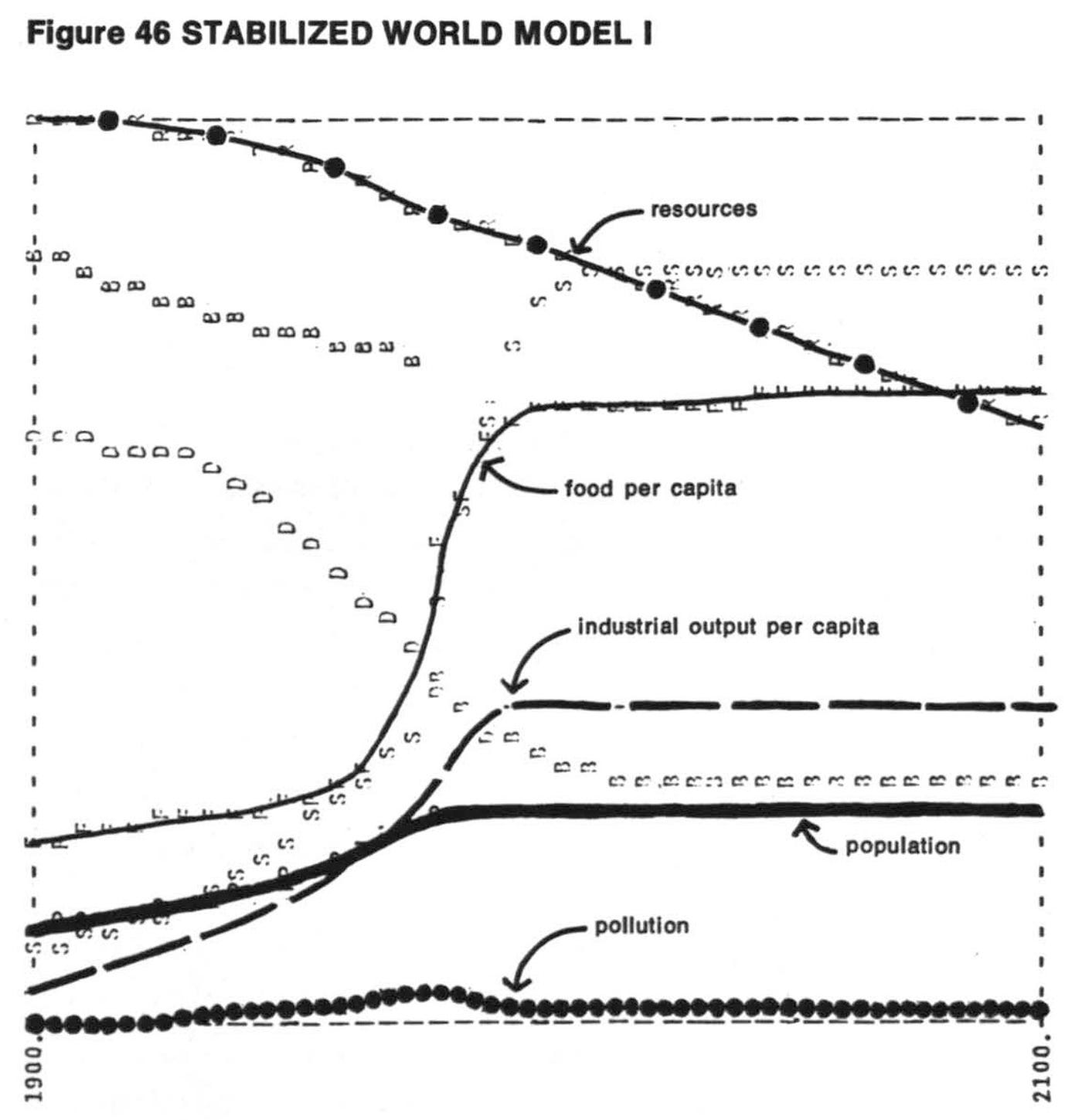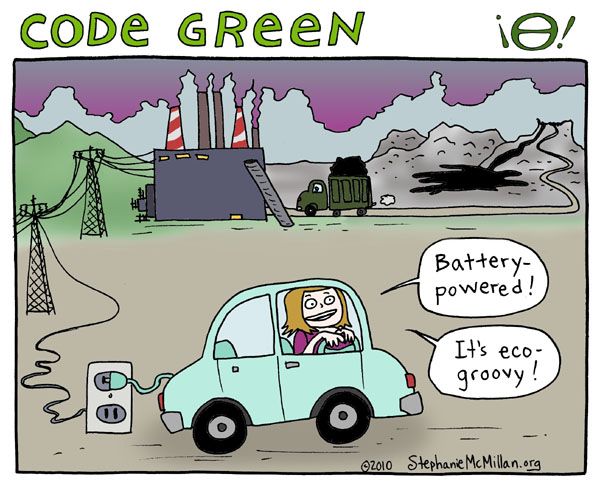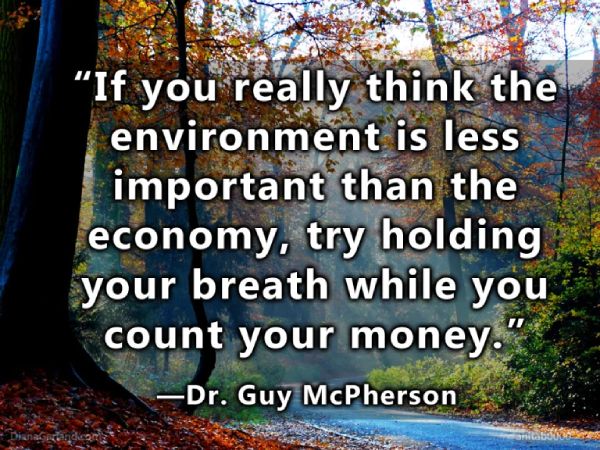The Limits to Growth, published in 1972, ran thoughtful computer models of our future up to 2100. The models were explicitly not predictions, but as a 2009 retrospective said,
Its predictions have not been invalidated and in fact seem quite on target. We are not aware of any model made by economists that is as accurate over such a long time span.
This is unfortunate because its (not) predictions are terrible.
Almost every single ‘run’ of the program has civilization crashing by 2100. Collapse is the default state. The few runs that don’t crash are because we, effectively, crash it ourselves. What is required is nothing short of global climate communism, bold 50-year plans implemented rigidly (ie, violently). And yet even this hopeless debate is also pointless, because it needed to be done 50 years ago. We have no concept of what ‘winning’ requires and — even if we did — we’re way too late.
I cover the ‘winning’ scenarios here not because they’re possible but because they’re not. Understanding what winning actually looks like can help us understand the losing state we’re in. Even in our wildest hypothetical imaginings (if I ruled the world and everyone thought the right things) we do not imagine what’s actually required. Because it’s absolutely brutal. Someone/something would have to take global power, kill the rich, crush the corporations, and rule humanity with an iron fist to wrench our ambitions down to Earth. This is what ‘winning’ looks like. You don’t want it and even if you did, it’s already been sold out.
Reading The Graphs
My reference for this essay is the book The Limits to Growth. You should just read it, but if you’re going to just read the graphs here, there are a few things to understand. A rule of thumb is that we’re looking for flat lines and not the violent up-and-to-the-right that tech bros delight in. Exponential growth is, as Dr. Tom Murphy says, being beaten to death with hockey sticks. Every meteoric rise we’re so proud of is effectively another meteor crashing into Earth, causing this mass extinction. Every action has a reaction. What we traditionally (ie: economically) don’t measure is that steep artificial growth has a steep natural cost.
The Limits to Growth tries to look at the whole system, both credits and debits. System dynamics tries to look at all the (major) interacting parts, which is what all the lines on these graphs capture. Hence for everything going up (population, industrial growth) you’ll find corresponding lines (resources, pollution) going down (or up, which can also be bad). If you’re looking to balance the books, anything going up or down is bad. What you’re looking for is balance, ie flat lines. And there’s really only one model the authors found that accomplishes that.
The Winning Scenario

In the one winning scenario, both human population and artificial (ie, corporate) growth are stopped and hypothetical technology advances keep us from burning through resources and drowning in our own waste. And so we survive, in vaguely recognizable form, without complete, unplanned collapse. Winning, right?
Well, I have two bits of news for you, and they’re both bad.
1. Too Little
How exactly does the winning run happen? A global two-child policy (from 1975) and a stop to anybody making ‘real’ money in 1990. Almost all industrial resources would have to be diverted to food, health, and education (ie, not luxury cars and fancy consumer goods) and everything would have to be centrally planned and distributed. Someone would need to grab the wheel of this civilization, slam on the brakes, and beat the shit out of anybody in the back who complained.
The authors of the book bloodlessly say “the most basic definition of of global equilibrium is that population and capital are essentially stable, with forces tending to increase or decrease in a fully controlled balance,” but c’mon. Who’s doing the controlling, and how? The authors don’t come out and say it, but this model is global climate communism, with someone as ‘authoritarian’ as Mao or Stalin to enforce it. We all know changes this big can’t be done without killing the rich, taking their shit, and silencing anyone who causes problems. But we somehow want to solve the biggest, dirtiest problem in human history without getting our hands dirty at all.
What the model doesn’t say is that you’d have to kill a significant amount of the population to execute this plan (which would actually improve the model’s performance, because less population). Everybody else would be wildly oppressed by western standards. Given that Mao died in 1976 and did not take over the world (and also wanted more industrialization), none of this has happened. Even now, knowing the stakes, we still do not want it to happen. We, in our delicate sensibilities, consider the one ‘winning’ outcome monstrous and unthinkable. We simply cannot fathom what’s actually required to solve a ‘problem’ as big as ‘the climate’, and simply do not have the stomach for it.
People seem to want to solve a problem as big as ‘the climate’ (AKA the realm of gods) with very small concessions, like electric cars and solar panels; otherwise going on as before. This is not even remotely possible. There will be massive human sacrifice now, or the gods will take it all later. There is no third option. As the book says:
All the evidence available to us, however, suggests that of the three alternatives — unrestricted growth, a self-imposed limitation to growth, or a nature-imposed limitation to growth — only the last two are actually possible.
What we face is the old trolley problem with an additional, insurmountable kink. Picture a trolley about to run over the whole world forever (option 1), and you can only save it by throwing a switch to run over billions of people and zillions of dollars now (option 2). There is no option 3. If you make the train ‘green’ and electric it still runs over the world. Note that this model isn’t myopically focused on CO₂ like us today, they talk about pollution and resource use in general, which any sort of growth still does.
Given these choices, set by physics, what do we — or more specifically — what did we choose? Well, we chose to not choose, but rather to dither and pretend for 50 years. Which takes us to the default state (uncontrolled collapse), just in ignorant bliss. As the book says,
Accepting the nature-imposed limits to growth requires no more effort than letting things take their course and waiting to see what will happen. The most probable result of that decision, as we have tried to show here, will be an uncontrollable decrease in population and capital.
Letting things take their course is broadly what we’ve done. We’re still releasing more and more data, and not fundamentally doing anything except changing the type of products we have within capitalism, not overturning the whole apple cart, as is required. We’ve had 27 COP meetings kicking the can down the road and now here we are, with the trolley at our throats. Our current response to climate collapse is the textbook definition of ‘too little’, and it is also, unfortunately, too late.
2. Too Late
If you get the right answer, five decades after the exam, it doesn’t fucking count, does it? As you must have noticed, the one working ‘run’ had us stabilizing human population in 1975 (before I was born) and had artificial (economic) growth stopping in 1990. Neither of which happened. As Carole King said, “it’s too late baby, it’s too late, though we really did try to make it.” Except we really didn’t.
Even if Lenin, Mao, and Ho Chi Minh hopped out of embalment right now with a newfound respect for vegetables, we’d still be completely fucked. As mentioned in point #1, we’re already way too late. If you run the same climate communism program in 2000 (again, still in the past! still too late!), it doesn’t work. The ‘too late’ run goes like this:

As you can see, rather than stabilizing, everything we care about (food, industrial capacity, resources) go into a long decline. It’s losing, just on a slightly longer timeline. You can’t un-eat resources that have already been consumed. You can’t stuff the farts back in the butt. As Lady Macbeth said, “what’s done is done, and cannot be undone.” And as the authors said about the missed time from 1975 to 2000:
During the 25-year delay (from 1975 to 2000) in instituting the stabilizing policies, resource consumption is about equal to the total 125-year consumption from 1975 to 2100 of figure 47.
Now bear in mind that we are already another ≈25 years ahead now, which is nearly twice as bad, given exponential growth. It’s too late, and pledges for another 25 years in the future are a joke. We overshot our heads off long ago. We’re a bunch of chickens with our heads cut off, driving around in a Tesla. It’s simply too late. It’s just taking a while for the bodies to fall.
Winning Sucks
As you can see, ‘winning’ against climate change was wildly implausible in the 1970s and is physically impossible today. The two elements that these authors said were necessary 50 years ago were 1. “a realistic, long-term goal that can guide mankind to the equilibrium society” and 2. “the human will to achieve that goal.” And we’re still talking about #1 today! In 2023!
This may be the first time you’re hearing about a ‘realistic long-term goal’, and how much it sucks. I’m also just hearing about it now, when it should have been discussed before I was born. Speaking about will, ‘we’ do not exist in any coherent sense to take action, this royal ‘we’ is too late if we wanted to, and we don’t want to. Do you want to win? Do you want to go destroy this still widely comfortable civilization, so some unborn people can live in reduced conditions 80 years hence? Do you even know what real sacrifice means?
I’ll be honest, I don’t. But I know what that means. The Buddha said attachment and ignorance lead to suffering, and that’s where we’re collectively going. Our short-term addictions lead to rock bottom for our descendants soon enough. As the authors say, “Without such a goal and a commitment to it, short-term concerns will generate the exponential growth that drives the world system toward the limits of the earth and ultimate collapse.”
So here we are, headless chickens in a Tesla, driving headlong towards the limits of the Earth, and the ultimate collapse of life as we know it. It’s too late to win, we don’t actually want to win, and that leads to the logical conclusion. Losing. So what, exactly, does losing look like? That’s what we’ll get to next. Both literally and, well, literally. I’ll write about it but you can also just look outside. This world is lost. It’s already been sold out. These are just receipts.









